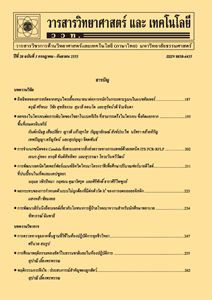การวิเคราะห์ปัจจัยที่ส่งผลดีต่อการมีชีวิตอยู่รอดและสภาวะของผู้ป่วยโรคเอดส์ด้วยตัวแบบเชิงเส้นนัยทั่วไป
Main Article Content
Abstract
บทคัดย่อ
การวิเคราะห์การมีชีวิตอยู่รอดและสภาวะกิจกรรมของผู้ป่วยโรคเอดส์ด้วยตัวแบบเชิงเส้นนัยทั่วไปแบ่งเป็น 2 กรณี คือ ตัวแปรตอบสนองมี 2 กลุ่ม : มีชีวิตอยู่และเสียชีวิต อาศัยตัวแบบลอจิต 2 กลุ่ม (binary logit model) และกรณีที่ตัวแปรตอบสนองมี 3 กลุ่ม : สภาวะที่ผู้ป่วยสามารถทำกิจกรรมได้ตามปกติ ผู้ป่วยสามารถทำกิจกรรมได้ตามปกติแต่เริ่มมีอาการแสดงของโรค และผู้ป่วยไม่สามารถทำกิจกรรมได้ตามปกติ อาศัยตัวแบบลอจิตสะสม (cumulative logit model) โดยศึกษาปัจจัยที่เกี่ยวข้องจำนวน 11 ตัวแปร ได้แก่ ระยะเวลาตั้งแต่วินิจฉัยการเป็นโรคเอดส์จนกระทั่งเสียชีวิตหรือสิ้นสุดการทดลอง ผลการวินิจฉัยระยะเวลาการมีชีวิตอยู่ของผู้ป่วย ประเภทของการรักษาผู้ป่วย ประเภทกลุ่มยาที่ใช้ในการรักษาผู้ป่วย เพศ เชื้อชาติ ประวัติการใช้ยาเสพติด โรคฮีโมฟีเลีย ระดับเซลล์เม็ดเลือดขาว ระยะเวลาของการใช้ยา zidovudine และอายุ จากข้อมูลจริงจำนวน 1,151 คน การประมวลผลใช้โปรแกรมสำเร็จรูป SAS Enterprise Guide version 5.1 ผลการวิจัยพบว่าปัจจัยที่ส่งผลต่อการมีชีวิตอยู่ของผู้ป่วยโรคเอดส์อย่างมีนัยสำคัญทางสถิติที่ 0.05 มีจำนวน 3 ปัจจัย คือ ระดับเซลล์เม็ดเลือดขาว ประเภทของการรักษาผู้ป่วย และผลการวินิจฉัยระยะเวลาการมีชีวิตอยู่ของผู้ป่วย ส่วนปัจจัยที่ส่งผลต่อสภาวะกิจกรรมของผู้ป่วยอย่างมีนัยสำคัญทางสถิติที่ 0.05 คือ ระยะเวลาตั้งแต่วินิจฉัยการเป็นโรคเอดส์จนกระทั่งเสียชีวิตหรือสิ้นสุดการทดลอง ระดับเซลล์เม็ดเลือดขาว และอายุ โดยตัวแบบเชิงสถิติทั้ง 2 กรณี มีภาวะสารูปดีและเหมาะสมกับข้อมูลอย่างมีนัยสำคัญทางสถิติที่ 0.05
คำสำคัญ : ตัวแบบเชิงสถิติ; การพยากรณ์ความน่าจะเป็น; ตัวแบบลอจิตสองกลุ่ม; ตัวแบบลอจิตสะสม
Abstract
The analysis of status of living and kanofsky performance scale of aids patients consists of two cases. Firstly, the response was divided into two groups: alive and death, using a binary logit model. Secondly, the response was divided into three groups: normal activities, normal activities with the sense of disease, and unable to do activities, using a cumulative logit model. The eleven factors consist of time from AIDS diagnosis to death, estimated time to death, treatment indicator, treatment group indicator, sex, race, drug use history, hemophiliac, white blood cell level, prior ZDV use, and age. The real experimental data were from 1,151 AIDS patients. All data was processed using SAS Enterprise Guide version 5.1. The results revealed that the factors effecting the status living of the response significantly at 0.05 are white blood cell level (cd4), treatment indicator, and estimated time to death. The factors effecting the kanofsky performance scale of the response significantly at 0.05 are time from AIDS diagnosis to death (time), cd4, and age. Moreover, both logit models have adequacy of fits for the data significantly at 0.05.
Keywords: statistical model; probability forecasting; logit model; binary logit mode; cumulative logit model


